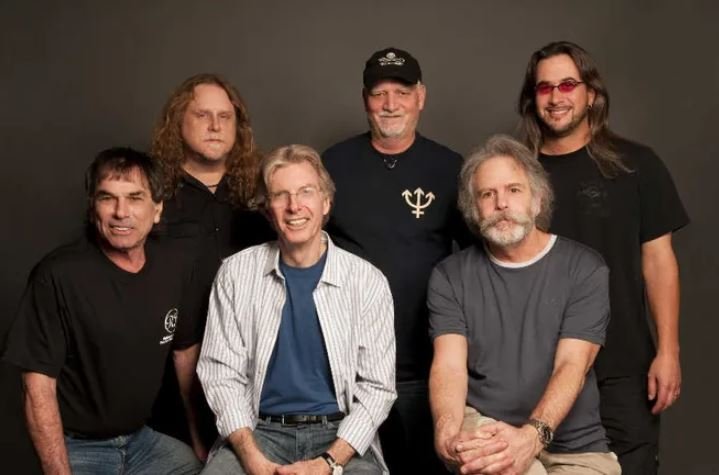Early Beginnings and Formation
The Grateful Dead, one of the most iconic and influential bands in rock history, was formed in Palo Alto, California, in 1965. The band emerged from the heart of the 1960s counterculture movement, embodying the free-spirited and experimental ethos of the time.
The original lineup included Jerry Garcia (lead guitar and vocals), Bob Weir (rhythm guitar and vocals), Ron “Pigpen” McKernan (keyboards and vocals), Phil Lesh (bass), and Bill Kreutzmann (drums).
Initially known as the Warlocks, the band changed its name to the Grateful Dead after discovering that another band was already using the Warlocks moniker.
According to legend, the name “Grateful Dead” was chosen from a dictionary entry that referenced a folktale about a traveler who helps a deceased soul find peace. This mystical and somewhat eerie origin perfectly suited the band’s eclectic and often otherworldly music.
Musical Style and Influence
The Grateful Dead is renowned for their unique blend of rock, folk, country, bluegrass, blues, and jazz, creating a genre-defying sound that resonated with a wide range of listeners.
Their music was characterized by improvisational jams, complex song structures, and a fusion of various musical styles. The band’s live performances became legendary, often featuring extended improvisations that would take their audience on a musical journey.
One of the defining features of the Grateful Dead was their commitment to live music. They were known for their extensive touring and marathon concerts, where no two performances were ever the same.
This dedication to live performance fostered a devoted fan base known as “Deadheads,” who would follow the band from show to show, creating a unique subculture around the band.
Breakthrough and Popular Songs
The Grateful Dead’s first album, The Grateful Dead (1967), established them as a key player in the burgeoning San Francisco music scene. However, it was their third album, Aoxomoxoa (1969), and particularly their fourth album, Live/Dead (1969), that began to solidify their reputation as pioneers of the psychedelic rock genre.
The band’s commercial breakthrough came with the release of Workingman’s Dead (1970) and American Beauty (1970), two albums that marked a shift towards a more folk and country-influenced sound.
These albums included some of their most enduring songs, such as “Uncle John’s Band,” “Casey Jones,” “Friend of the Devil,” and “Ripple.” These tracks became staples of the band’s live performances and are considered classics of the rock canon.
Another significant milestone in the Grateful Dead’s career was the release of the live album Europe ’72 (1972), which captured the band at their improvisational best. The album featured several new songs that would become fan favorites, including “Jack Straw” and “Tennessee Jed.”
READ ALSO: Ramble On Rose Lyrics
Cultural Impact and Legacy
The Grateful Dead’s impact on music and popular culture is immeasurable. They were not only a musical force but also a social and cultural phenomenon.
The band’s dedication to live music, their refusal to conform to industry norms, and their close relationship with their fan base set them apart from their contemporaries.
Their approach to live recordings was revolutionary. They encouraged fans to tape their concerts, which helped to spread their music and build a community of dedicated followers.
This practice of allowing audience recordings contributed to the band’s enduring legacy and the widespread availability of their live performances.
The Grateful Dead also embraced technology, being one of the first bands to use a sophisticated sound system known as the “Wall of Sound,” which provided unparalleled audio quality during their concerts.
Later Years and Continuation of the Legacy
The Grateful Dead continued to tour and produce music through the 1970s and 1980s, although their studio output slowed. They experienced a resurgence in popularity in the late 1980s with the release of the album In the Dark (1987), which featured the hit single “Touch of Grey.” This song became their first and only top 10 hit, bringing them newfound commercial success.
The band’s journey, however, was not without challenges. They faced personal and professional struggles, including the loss of key members.
Ron “Pigpen” McKernan died in 1973, and keyboardists Keith Godchaux and Brent Mydland also passed away during the band’s tenure. Despite these losses, the band continued to evolve and grow.
Jerry Garcia, the band’s charismatic leader and primary songwriter, passed away in 1995, marking the end of the Grateful Dead as a touring entity.
However, the music and legacy of the Grateful Dead continue to live on. Surviving members have continued to perform under various names, such as The Dead and Dead & Company, keeping the spirit of the band alive.
Conclusion
The Grateful Dead’s influence extends far beyond their music. They helped to shape the culture of the 1960s and 1970s, leaving an indelible mark on rock music and the counterculture movement.
Their innovative approach to live performance, their fusion of musical genres, and their deep connection with their fans have cemented their place as one of the most significant bands in music history.
Popular songs like “Truckin’,” “Sugar Magnolia,” “Friend of the Devil,” and “Touch of Grey” continue to be celebrated by new generations of fans, ensuring that the Grateful Dead’s legacy endures.
The Grateful Dead were more than just a band; they were a cultural phenomenon that redefined the possibilities of what music and community could be.

